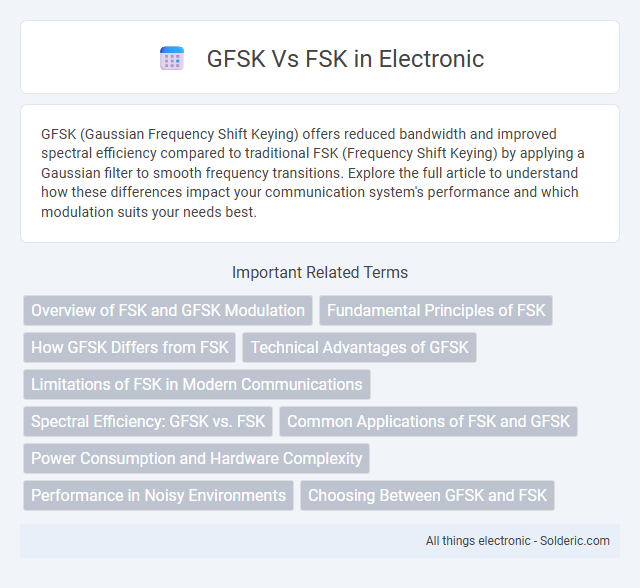GFSK (Gaussian Frequency Shift Keying) offers reduced bandwidth and improved spectral efficiency compared to traditional FSK (Frequency Shift Keying) by applying a Gaussian filter to smooth frequency transitions. Explore the full article to understand how these differences impact your communication system's performance and which modulation suits your needs best.
Comparison Table
| Feature | GFSK (Gaussian Frequency Shift Keying) | FSK (Frequency Shift Keying) |
|---|---|---|
| Modulation Type | Continuous-phase frequency modulation | Discontinuous-phase frequency modulation |
| Bandwidth Efficiency | High (uses Gaussian filter to reduce bandwidth) | Lower (no filtering, wider spectrum) |
| Interference & Noise Immunity | Better immunity due to smoother transitions | Moderate immunity, more susceptible to noise |
| Power Efficiency | More power efficient | Less power efficient |
| Complexity | Higher (requires Gaussian filtering) | Lower (simpler implementation) |
| Applications | Bluetooth, Wireless LAN, RFID | Modems, Radio communication, Telemetry |
| Signal Shape | Smoothed phase transitions | Sharp frequency transitions |
Overview of FSK and GFSK Modulation
Frequency Shift Keying (FSK) is a digital modulation technique where the frequency of the carrier signal shifts between discrete values to represent binary data, ensuring robustness in noisy environments. Gaussian Frequency Shift Keying (GFSK) enhances FSK by applying a Gaussian filter to the modulating signal before frequency shifting, which reduces bandwidth and minimizes spectral interference. Your communication system benefits from GFSK's improved spectral efficiency and reduced out-of-band emissions compared to standard FSK, making it ideal for wireless protocols like Bluetooth.
Fundamental Principles of FSK
Frequency Shift Keying (FSK) modulates digital signals by shifting the carrier frequency between discrete values, representing binary data as distinct frequency tones. Gaussian Frequency Shift Keying (GFSK) enhances FSK by applying a Gaussian filter to smooth frequency transitions, reducing bandwidth and minimizing interference. Your choice between FSK and GFSK impacts signal clarity and spectral efficiency, with GFSK often preferred in wireless communication standards like Bluetooth.
How GFSK Differs from FSK
GFSK (Gaussian Frequency Shift Keying) differs from FSK (Frequency Shift Keying) by applying a Gaussian filter to the digital signal before frequency modulation, which smooths the frequency transitions and reduces bandwidth usage. This filtering process minimizes signal sidebands and interference, enhancing spectral efficiency and making GFSK ideal for wireless communication protocols like Bluetooth. If you're optimizing your system for low power and efficient spectrum use, GFSK offers advantages over standard FSK modulation.
Technical Advantages of GFSK
GFSK offers superior spectral efficiency compared to traditional FSK by smoothing frequency transitions through Gaussian filtering, which reduces signal bandwidth and minimizes interference. This technique lowers bit error rates in noisy environments, enhancing the reliability of data transmission for your wireless communication systems. Its constant envelope characteristic also enables power-efficient amplification, making GFSK ideal for battery-powered and low-power applications.
Limitations of FSK in Modern Communications
Frequency Shift Keying (FSK) faces limitations in modern communications primarily due to its susceptibility to noise and lower spectral efficiency compared to Gaussian Frequency Shift Keying (GFSK). FSK's abrupt frequency transitions generate wider spectral bandwidths, causing increased interference and reduced performance in crowded frequency bands. GFSK enhances modulation by smoothing these transitions with a Gaussian filter, resulting in improved error rates and better compatibility with high-density wireless environments.
Spectral Efficiency: GFSK vs. FSK
GFSK (Gaussian Frequency Shift Keying) offers higher spectral efficiency compared to traditional FSK by applying a Gaussian filter to the baseband signal, which reduces bandwidth and limits out-of-band emissions. This filtering smooths the frequency transitions, enabling more efficient use of the available spectrum and minimizing interference with adjacent channels. For your communication system, choosing GFSK can significantly optimize bandwidth utilization while maintaining reliable data transmission.
Common Applications of FSK and GFSK
FSK (Frequency Shift Keying) is widely used in low-speed data communication applications such as RFID systems, caller ID transmission, and simple wireless sensor networks due to its robustness and simplicity. GFSK (Gaussian Frequency Shift Keying), a variation of FSK that smooths frequency transitions with a Gaussian filter, is preferred in Bluetooth, GSM, and other wireless communication standards for its improved spectral efficiency and reduced interference. Your choice between FSK and GFSK depends on the specific application requirements for bandwidth efficiency and noise tolerance.
Power Consumption and Hardware Complexity
GFSK (Gaussian Frequency Shift Keying) typically consumes less power than standard FSK due to its smoother signal transitions, reducing high-frequency components and enabling more efficient power amplifier operation. The Gaussian filtering in GFSK adds moderate hardware complexity compared to basic FSK, which uses simpler modulation without pulse shaping. This trade-off results in GFSK being preferred in low-power wireless applications like Bluetooth, where both power efficiency and manageable hardware complexity are critical.
Performance in Noisy Environments
GFSK (Gaussian Frequency Shift Keying) offers improved performance in noisy environments compared to standard FSK due to its Gaussian filter that smooths the signal, reducing bandwidth and minimizing intersymbol interference. This filtering enhances signal resilience against noise and multipath fading, making GFSK ideal for low-power, narrowband wireless communications such as Bluetooth. FSK, while simpler and less bandwidth-efficient, tends to be more susceptible to noise and interference, resulting in higher bit error rates under the same conditions.
Choosing Between GFSK and FSK
Choosing between GFSK and FSK depends on your application's need for spectral efficiency and interference resistance. GFSK offers better bandwidth efficiency and reduced sideband power, making it ideal for wireless communication in crowded environments. FSK provides simpler implementation and is more robust in noisy channels, which suits cost-sensitive or less complex systems.
GFSK vs FSK Infographic

 solderic.com
solderic.com